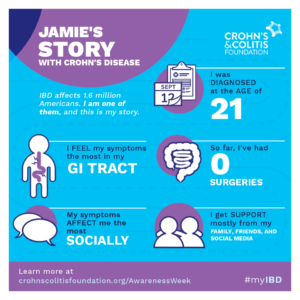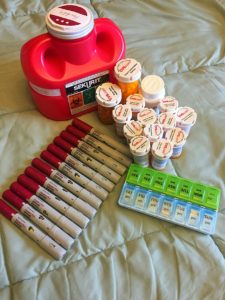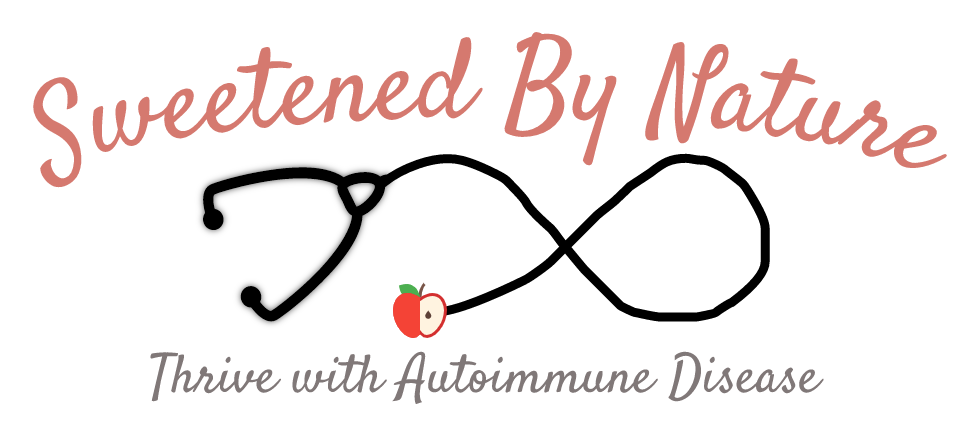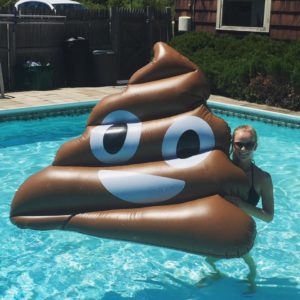Today is day 1 of IBD Awareness Week! IBD stands for Inflammatory Bowel Disease, which includes both Crohn’s disease and Ulcerative Colitis. The symptoms of Crohn’s and colitis are very similar, and include diarrhea (sometimes bloody), nausea, weight loss, abdominal pain, fever, and many extra-intestinal manifestations. Crohn’s disease can affect any part of the gastrointestinal tract from the mouth to the anus, and ulcerative colitis is limited to the colon. For more information the differences between, diagnosis, and treatment of Crohn’s and ulcerative colitis, click here.

My Crohn’s Diagnosis
I was diagnosed with Crohn’s disease during my senior year of college after dealing with gastrointestinal problems for as long as I could remember. I had somewhat managed my symptoms over the years with diet (gluten, dairy & somewhat refined sugar free). However, the fall of my senior year of college, I fell into a big flare that ultimately led to my diagnosis of Crohn’s disease. When I should have been going out all the time and taking full advantage of my senior year of college, aka my last year of “freedom” before medical school started, I was very sick. I do not think I realized how sick I was at the time, but looking back, I am so thankful for how far I have come over the years.
In a short couple months, I lost nearly 15% of my body weight that I did not have to lose. My stomach ached constantly, I was constantly rushing to the bathroom, my mouth was full of sores, and I had no energy. My knees and joints ached so much, to the point that even sitting in a chair or laying in bed was painful. I would get drenching night sweats to the point I would sleep on a towel and need to change my clothes up to five times a night.
A month before my Crohn’s diagnosis, I was also diagnosed with gastroparesis, which means paralyzed stomach. My stomach did not empty as quickly as it should after eating, which caused nausea, vomiting, and extreme bloating. I tolerated food better earlier in the day. If I ate in the afternoon or later, I would be so uncomfortable, I could not sleep. What helped my digestion the most was walking after eating, and eating smaller meals more frequently.
During winter break of my senior year, I had a colonoscopy and was diagnosed with Crohn’s disease. For more information on my story, click here.
Wait, there’s no cure?
While the diagnosis of a lifelong disease is scary, I felt relieved at the same time. I trusted my doctors and knew if what plagued me had a name, my doctors and I could come up with a plan to treat me. If I never suffered from gastrointestinal problems, I would never have developed my passion for healthy cooking, preventative medicine, and self-care. I also would never have been part of the incredible Autoimmune Protocol and Crohn’s & Colitis community.
Why do we need awareness?
1.6 million Americans have IBD, so this disease is not rare at all. There are several treatments available, but the side effects profiles are scary. Additionally, these drugs do not work for everybody. In less than two years, I have been on four different medications after failing the first three. I recently had to come off of medication #4 due to an infection that my body cannot fight while immunocompromised.

Furthermore, most diseases are invisible, and we need to raise awareness about these invisible illnesses. Someone might look amazing from the outside but be suffering immensely on the inside. These illnesses can be physical, mental, or both. Because we do not always know what our peers are battling on the inside, we need to make a conscious effort to be kind always. Being kind is simple. Smile, compliment others, and be helpful. Truly ask your friends and family how they are doing. Listen. Be a shoulder to cry on. Laugh always.
I will try to post the rest of the week to keep raising awareness. Individually, we may feel small, but together, we can make a huge impact. I am sending my love to you all! <3
 Copyright secured by Digiprove © 2018 Jamie Horrigan
Copyright secured by Digiprove © 2018 Jamie Horrigan


Leave a Reply